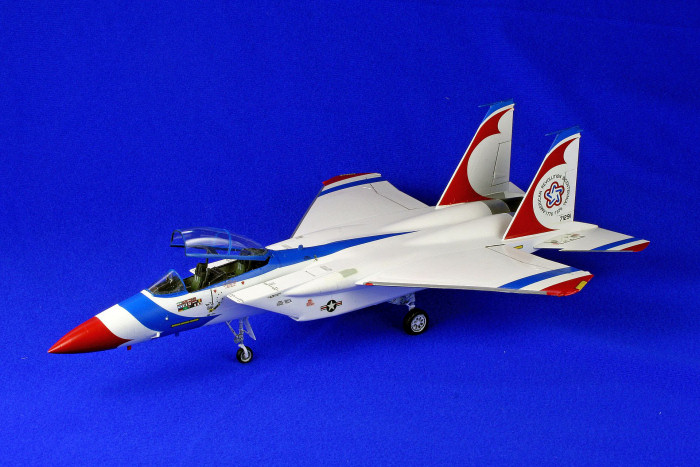
Hasegawa 1/72 TF-15 Eagle 'Bicentennial' Kit Build Review
By Chuck Holte
| Date of Review | April 2014 | Manufacturer | Hasegawa |
|---|---|---|---|
| Subject | TF-15 Eagle 'Bicentennial' | Scale | 1/72 |
| Kit Number | 00069 | Primary Media | Styrene |
| Pros | Accuracy, Unique Subject | Cons | Some fit issues, decals |
| Skill Level | Experienced | MSRP (USD) | Out of Production |
Build Review
The subject of this build review is identified on the handsome top opening box cover as a "TF-15," and so it was originally designated in the early 1970s. The TF-15A was soon re-designated as an F-15B. This particular aircraft, USAF 71-0291, was the second two-seat "B model" Eagle off the McDonald Douglas (now Boeing) production line. Aircraft "291" had a long and productive career, appearing prominently in the USA Bicentennial scheme at the 1976 Farnborough (England) International Air Show and Display. Subsequently, "291" became a test-bed aircraft for the Conformal Fuel Tank (CFT) Program, the LANTIRN (Low Altitude Navigation and Targeting Infrared for Night) Pod, and was the prototype aircraft for the F-15E Strike Eagle Program. Sadly, as of 2005, "291" was reduced to serving as a Battle Damage Repair training hulk at Warner-Robins AFB GA.
The basic kit for the Bicentennial "291" is the Hasegawa F-15D/DJ, Kit K26, issued in 1988, but with new decals and two pages of painting and decal instructions issued in 2004. The original eight page assembly instructions and painting guide for the "D/DJ" is included in the box, but not the D/DJ decals.
The basic kit is unchanged from other reissues of the two-seat Eagle. It suffers from a complex join of the forward fuselage with the aft fuselage behind the cockpit, in the midst of the engine inlets, ramps, ducting, and speed brake. A little patience, practice fitting and adjustment will be necessary to avoid an unsightly joint in that area. Otherwise the assembly is quite simple and only minor filling and sanding was required. Cockpit detail consists of high relief depictions of the various panels, screens, switches and detail that can be painted or decaled. I hand painted the front and rear instrument panels and used the decals for the side consoles. I found the kit's eight piece cockpit and four piece ejection seats fine for the scale, but some modelers may want the more detailed effect of available aftermarket resin and PE sets.
I primed the assembled model with rattle-can Tamiya Fine Surface Primer and then used Tamiya rattle-can TS-26 Pure White for the top coat. Alclad Aluminum was used for the hot areas of the aft engine bays and Model Master Gunmetal was used for the exhaust cans.
The kit's large red, clear and blue Hasegawa decals promised to ease a lot of complex masking and painting and generally "make" the colorful model. The decals were strong enough as they were applied and would stand a lot of coaxing, but I found them very difficult to work down into wrinkle free application over the gloss white lacquer finish. After much slicing and dicing to get everything to fit, I found they did not "stick" very well and would flake off at the slightest provocation, even with Micro Sol and Solveset. The nose was the worst – I ended up removing most of red decal and carefully matching the paint to airbrush the nosecone. Were I to do it again, I would use the kit decals as masking patterns and airbrush all the bicentennial markings. Granted, the decals were 10 years old, but they caused me a lot of grief on an otherwise enjoyable build.
After decaling, a final airbrushed coat of Floquil Flat brought back the desired finish.
I wanted a colorful Eagle model in my display case to contrast with the normal grays. The Bicentennial Eagle definitely fits that requirement and was overall an enjoyable build, but the kit decals were a lot of work. Recommended for the experienced builder due to the old decals.
















